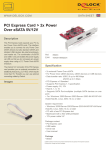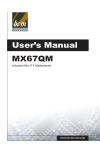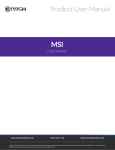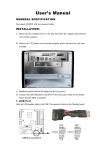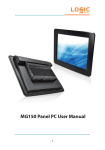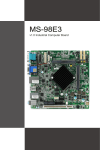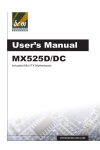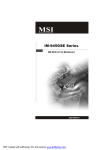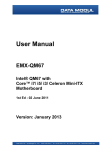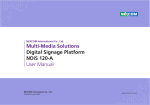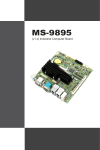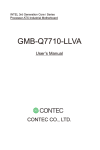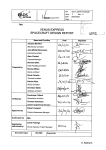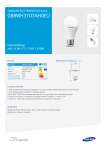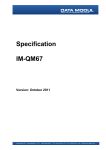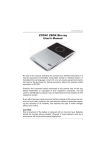Download User`s Manual V1.0 Intel® Q77 Micro ATX Motherboard (uATX
Transcript
RX77Q
User’s Manual
Intel® Q77 Micro ATX Motherboard (uATX) supports
2nd/3rd Gen. 22nm Intel® Core™ i7 / i5 / i3 Processors
V1.0
▍ Preface
Copyright Notice
The material in this document is our intellectual property. We take every
care in the preparation of this document, but no guarantee is given as to the
correctness of its contents. Our products are under continual improvement
and we reserve the right to make changes without notice.
Trademarks
All trademarks are the properties of their respective owners.
■
■
■
■
Intel® is registered trademarks of Intel Corporation.
Windows® is registered trademarks of Microsoft Corporation.
AMI® is registered trademark of Advanced Micro Devices, Inc.
Realtek® is registered trademark of Realtek Semiconductor Corporation.
ii
RX77Q
Safety Instructions
■
■
■
■
■
■
■
■
■
■
Always read the safety instructions carefully.
Keep this User’s Manual for future reference.
Keep this equipment away from humidity.
Lay this equipment on a reliable flat surface before setting it up.
Make sure the voltage of the power source and adjust properly 110/220V
before connecting the equipment to the power inlet.
Place the power cord such a way that people can not step on it. Do not
place anything over the power cord.
Always Unplug the Power Cord before inserting any add-on card or module.
All cautions and warnings on the equipment should be noted.
Never pour any liquid into the opening that could damage or cause electrical shock.
If any of the following situations arises, get the equipment checked by service personnel:
◯
◯
◯
◯
■
◯
◯
The power cord or plug is damaged.
Liquid has penetrated into the equipment.
The equipment has been exposed to moisture.
The equipment does not work well or you can not get it work according
to User’s Manual.
The equipment has dropped and damaged.
The equipment has obvious sign of breakage.
DO NOT LEAVE THIS EQUIPMENT IN AN ENVIRONMENT UNCONDITIONED, STORAGE TEMPERATURE ABOVE 80oC (176oF), IT MAY DAMAGE THE EQUIPMENT.
CAUTION: Danger of explosion if battery is incorrectly replaced. Replace only with
CAUTION
the same or equivalent type recommended by the manufacturer.
For better environmental protection, waste batteries should be
collected separately for recycling or special disposal.
iii
▍ Preface
CE Conformity
Hereby, we declare that this device is in compliance with the
essential safety requirements and other relevant provisions set
out in the European Directive.
FCC-B Radio Frequency Interference Statement
This equipment has been tested and found to comply with the limits for a Class
B digital device, pursuant to Part 15 of the FCC Rules. These
limits are designed to provide reasonable protection against
harmful interference in a residential installation. This equipment generates, uses and can radiate radio frequency energy
and, if not installed and used in accordance with the instruction manual, may
cause harmful interference to radio communications. However, there is no guarantee that interference will not occur in a particular installation. If this equipment
does cause harmful interference to radio or television reception, which can be
determined by turning the equipment off and on, the user is encouraged to try to
correct the interference by one or more of the measures listed below:
■
■
■
■
Reorient or relocate the receiving antenna.
Increase the separation between the equipment and receiver.
Connect the equipment into an outlet on a circuit different from that to
which the receiver is connected.
Consult the dealer or an experienced radio/television technician for help.
NOTICE 1
The changes or modifications not expressly approved by the party responsible
for compliance could void the user’s authority to operate the equipment.
NOTICE 2
Shielded interface cables and AC power cord, if any, must be used in order to
comply with the emission limits.
This device complies with Part 15 of the FCC Rules. Operation is subject to the
following two conditions:
1.
this device may not cause harmful interference, and
2.
this device must accept any interference received, including interference
that may cause undesired operation.
iv
RX77Q
WEEE Statement
Under the European Union (“EU”) Directive on Waste Electrical and Electronic Equipment, Directive 2002/96/EC, which takes effect on August 13,
2005, products of “electrical and electronic equipment” cannot be discarded
as municipal waste anymore and manufacturers of covered electronic equipment will be obligated to take back such products at the end of their useful life.
v
▍ Preface
Contents
Copyright Notice ................................................................................. ii
Trademarks .........................................................................................ii
Safety Instructions ............................................................................. iii
CE Conformity.................................................................................... iv
FCC-B Radio Frequency Interference Statement .............................. iv
WEEE Statement ................................................................................v
Chapter 1 Overview ............................................................................... 1-1
Mainboard Specif cations ................................................................ 1-2
Mainboard Layout ........................................................................... 1-4
Block Diagram................................................................................. 1-5
Chapter 2 Hardware Setup.................................................................... 2-1
Quick Components Guide ............................................................... 2-2
CPU (Central Processing Unit) ....................................................... 2-3
CPU & Cooler Installation .............................................................. 2-4
Memory ...........................................................................................2-6
Power Supply .................................................................................. 2-7
Back Panel I/O ................................................................................ 2-8
Connector ......................................................................................2-11
Jumper ..........................................................................................2-18
Slot ................................................................................................2-20
Chapter 3 BIOS Setup .......................................................................... 3-1
Entering Setup ................................................................................ 3-2
The Menu Bar ................................................................................. 3-4
Main .............................................................................................. 3-5
Advanced ....................................................................................... 3-7
Boot ............................................................................................. 3-13
Security ........................................................................................ 3-14
Chipset ......................................................................................... 3-16
Power ........................................................................................... 3-18
Exit ............................................................................................... 3-20
vi
Chapter 1
Overview
Thank you for choosing the RX77Q, an excellent industrial computer board.
Based on the innovative Intel® Cougar Point chipset
for optimal system ef f ciency, the RX77Q accommodates the Intel® Core i3/ i5/ i7/ Celeron processor
in socket LGA1 155 and supports up to four DDR3
1066/1333/1600 DIMM slots to provide the maximum of 32GB memory capacity.
In the advanced-level and mid-range market segment,
the RX77Q provides a high-performance solution for
today’s front-end and general purpose workstation, as
well as in the future.
▍2YHUYLHZ
Mainboard Specifications
CPU
(Optional)
■ ,QWHO&RUHLLL&HOHURQSURFHVVRULQVRFNHW
/*$
Chipset
■ ,QWHO43&+
Memory
■ ''5',00VORWV
■ 6XSSRUWVWKHPD[LPXPRI*%
LAN
■ *LJDELW)DVW(WKHUQHWE\,QWHO/ /0
*E(FRQWUROOHUV
SATA
■ 6$7$*EVSRUWVE\,QWHO&RXJDU3RLQW
■ 6$7$*EVSRUWVE\,QWHO&RXJDU3RLQW
RAID
■ 6$7$aVXSSRUW,QWHO5DSLG6WRUDJH7HFKQRORJ\
$+&,5$,'E\,QWHO&RXJDU3RLQW
Audio
■ +'$&RGHFE\5HDOWHN$/&
■ &RPSOLDQWZLWK$]DOLDVSHFV
Graphics
■ 6XSSRUWE\WKHLQVWDOOHGSURFHVVRU
Back Panel I/O
■
■
■
■
■
■
■
■
■
■
■
36PRXVHSRUW
36NH\ERDUGSRUW
9*$SRUW
'9,'SRUW
VHULDOSRUW
'LVSOD\SRUW
*LJDELW/$1MDFNV
86%SRUWV
/LQH,QDXGLRMDFN
/LQH2XWDXGLRMDFN
0LF,QDXGLRMDFN
Onboard
Connectors/
Pinheaders
■
■
■
■
■
■
■
■
86%SLQKHDGHUV
DPSOLILHUSLQKHDGHU
VHULDOSRUWFRQQHFWRUV
*3,2SLQKHDGHU
/9'6FRQQHFWRU
IURQWDXGLRSLQKHDGHU
FKDVVLVLQWUXVLRQSLQKHDGHU
63',)SLQKHDGHU
RX77Q
Slot
■
■
■
■
■
Form Factor
■ uATX: 244mm x 244mm
Environmental
■ Operating Temperature: 0oC to 60oC
■ Storage Temperature: -20oC to 80oC
■ Humidity: 5% ~ 90% RH, Non-Condensing
1 PCIe x16 slot (1st slot)
1 PCIe x1 slot (2nd slot)
1 PCIe x4 slot (3rd slot)
1 PCI slot (4th slot)
1 Mini-PCIe slot
1-3
▍ Overview
Mainboard Layout
COM Power Jumper
Power Connector
CPU
Fan Power
Connector
DIMM Slot
COM Power
Jumper
Serial Port
Connector
COM Power
Jumper
Serial Port
Connector
Serial Port
Connector
COM Power
Jumper
Serial Port
Connector
24-pin Power
Connector
Fan Power
Connector
Clear CMOS
Jumper
LVDS
Connector
PCI-E
Slot
Intel AMT ME
Jumper
S/PDIF
Pinheader
AT/ATX Jumper
Mini PCI-E Slot
PCI
Slot
Audio
Amplifier
Pinheader
LVDS Power
Front Panel Parallel Port
Jumper
Pinheader
Pinheader
Front Audio Pinheader LVDS Inverter Connector
SATA
Connector
Front USB
Pinheader
Chassis Intrusion
Pinheader
GPIO Pinheader
Back Panel I/O
Mouse Port
Serial Port
LAN Jack
LAN Jack
DVI-D Port
Line-In Jack
Line-Out Jack
Mic-In Jack
Keyboard
Port
1-4
VGA Port
USB 3.0
Port
USB 3.0
Port
DVI-D Port
Displayport
RX77Q
Block Diagram
1-5
Chapter 2
Hardware Setup
This chapter provides you with the information on
mainboard hardware configurations. Incorrect setting
of jumpers and connectors may damage your mainboard. Please pay special attention not to connect
these headers in wrong direction. DO NOT adjust any
jumper while the mainboard is powered on.
▍ Hardware Setup
Quick Components Guide
4-pin Power
Connector, p2-7
COM Power
Jumper, p
p2-19
p2
2
CPU,
p2-3
Fan Power
Connector,
p2-12
DIMM Slot,
p2-6
26
COM Power
mp
p p2-19
Jumper,
Serial Port
Connector,
p2-15
p
COM Power
C
Jumper, p2-19
J
Serial Port
S
Connector,
p2-15
COM Power
Jumper, p2-19
Serial Port
S
Connector,
C
p2-15
24-pin Power
Connector,
C
p2-7
Fan Power
Connector,
C
p2-12
Clear CMOS
Jumper, p2-18
LVDS
Connector,
p2-16
ME Jumper,
p2-18
AT/ATX Jumper,
A
AT
p2-19
p
p2
2
PCI-E
Slot,
p2-20
S/PDIF
F
Pinheader,
ader,
p2-17
PCI Slot,
p2-20
20
Audio
o
Amplifier
Pinheader,
p2-12
Mini PCI-E
M
Slot, p2-20
Front Panel
Pinheader,
p2-13
Parallel Port
Pinheader,
p2-17
Front Audio Pinheader,
p2-17
2-2
LVDS
S Power
Jumper,
p2-19
LVDS Inverter
Connector, p2-16
Front USB
Pinheader,
p2-14
Chassis Intrusion
C
Pinheader, p2-11
GPIO Pinheader,
p2-13
SATA Connector,
p2-11
RX77Q
CPU (Central Processing Unit)
When you are installing the CPU, make sure that you install the cooler to
prevent overheating. If you do not have the CPU cooler, consult your dealer
before turning on the computer.
Important
Overheating
Overheating will seriously damage the CPU and system. Always make sure
the cooling fan can work properly to protect the CPU from overheating.
Make sure that you apply an even layer of thermal paste (or thermal tape)
between the CPU and the heatsink to enhance heat dissipation.
Replacing the CPU
While replacing the CPU, always turn off the power supply or unplug the
power supply’s power cord from the grounded outlet first to ensure the
safety of CPU.
Introduction to LGA 1155 CPU
The surface of LGA 1155 CPU. Remember to apply some thermal paste
on it for better heat dispersion.
Alignment Key
Alignment Key
Yellow triangle is the Pin 1 indicator
2-3
▍ Hardware Setup
CPU & Cooler Installation
When you are installing the CPU, make sure the CPU has a cooler attached on the top to prevent overheating.
overheating Meanwhile, do not forget to
apply some thermal paste on CPU before installing the heat sink/cooler
fan for better heat dispersion.
Follow the steps below to install the CPU & cooler correctly. Wrong installation will cause the damage of your CPU & mainboard.
1.
Open the load lever.
2.
Lift the load lever up to fully
open position.
3.
After confirming the CPU
direction for correct mating,
put down the CPU in the
socket housing frame. Be
sure to grasp on the edge of
the CPU base. Note that the
alignment keys are matched.
4.
Remove the plastic cap.
Engage the load lever while
pressing down lightly onto
the load plate.
Important
Visually inspect if the CPU is seated well into the socket. If not, take out
the CPU with pure vertical motion and reinstall.
2-4
RX77Q
5.
Secure the lever near the
hook end under the retention tab.
6.
Make sure the four hooks are
in proper position before you
install the cooler. Align the
holes on the mainboard with
the cooler. Push down the
cooler until its four clips get
wedged into the holes of the
mainboard.
7.
Press the four hooks down to
fasten the cooler. Turn over
the mainboard to confirm
that the clip-ends are correctly inserted.
8.
Finally, attach the CPU Fan
cable to the CPU fan connector on the mainboard.
Important
•
Confirm if your CPU cooler is firmly installed before turning on your
system.
•
Do not touch the CPU socket pins to avoid damaging.
•
Whenever CPU is not installed, always protect your CPU socket pin
with the plastic cap covered to avoid damaging.
•
Please refer to the documentation in the CPU cooler package for more
details about the CPU cooler installation.
2-5
▍ Hardware Setup
Memory
These DIMM slots are intended for memory modules.
DDR3
240-pin, 1.5V
48x2=96 pin
72x2=144 pin
Installing Memory Modules
1.
The memory module has only one notch on the center and will only
fit in the right orientation.
2.
Insert the memory module vertically into the DIMM slot. Then push it
in until the golden finger on the memory module is deeply inserted in
the DIMM slot. You can barely see the golden finger if the memory
module is properly inserted in the DIMM slot.
3.
The plastic clip at each side of the DIMM slot will automatically
close.
Important
2-6
•
DDR3 memory modules are not interchangeable with DDR2 and the
DDR3 standard is not backwards compatible. You should always install DDR3 memory modules in the DDR3 DIMM slots.
•
To enable successful system boot-up, always insert the memory modules into the DIMM1 first.
RX77Q
Power Supply
24-Pin Power Connector: JPWR2
This connector allows you to connect an 24-pin power supply. To connect
the 24-pin power supply, make sure the plug of the power supply is inserted
in the proper orientation and the pins are aligned. Then push down the
power supply firmly into the connector.
d
n
u
ro
V
.G 5 V
4
2 3.+ +5 V
d
2 2. +5 s un d
2 1. e o n d
2 0.R Gr rou un #
2 9. G ro ON d
1 8. G - un
1 7. PS o
1 6. Gr 2V V
1 5. -1 .3
1 4. +3
1 3.
1
V
.3
3 V
.+ 2 V
2 1 2
1 1.+ +1 B OK
1 0. VS R nd
1 .5 W u
9 .P ro nd
8 .G 5V u
7 .+ ro nd
6 .G 5V u
5 + o V
r
.
4 .G 3.3 3V
3 .+ 3.
2 .+
1
4-Pin Power Connector: JPWR1
This 12V power connector is used to provide power to the CPU.
d
n
u d
ro un
.G ro
1 .G
2
V
2
1 V
.+ 2
3 .+1
4
Important
Make sure that all the connectors are connected to proper ATX power supplies to ensure stable operation of the mainboard.
2-7
▍ Hardware Setup
Back Panel I/O
Mouse Port
Serial Port
LAN Jack
LAN Jack
DVI-D Port
Line-In Jack
Line-Out Jack
Mic-In Jack
Keyboard
Port
VGA Port
USB 3.0
Port
USB 3.0
Port
DVI-D Port
Displayport
▶ Mouse/Keyboard Port
The standard PS/2 mouse/keyboard DIN connector is for a PS/2 mouse/
keyboard.
▶ VGA Port
The DB15-pin female connector is provided for monitor.
▶ DVI-D Port
The DVI-D (Digital Visual Interface-Digital) connector allows you to connect
an LCD monitor. It provides a high-speed digital interconnection between
the computer and its display device. To connect an LCD monitor, simply
plug your monitor cable into the DVI connector, and make sure that the other
end of the cable is properly connected to your monitor (refer to your monitor
manual for more information.)
▶ DisplayPort
DisplayPort is a digital display interface standard. This connector is used to
connect a monitor with DisplayPort inputs.
▶ USB 3.0 Port
USB 3.0 port is backward-compatible with USB 2.0 devices. It supports data
transfer rate up to 5 Gbit/s (SuperSpeed).
2-8
RX77Q
▶ RS-232/422/485 Serial Port Connector (Optional)
The serial port is a 16550A high speed communications port that sends/
receives 16 bytes FIFOs. You can attach a serial mouse or other serial
devices directly to the connector.
RS-232
PIN
SIGNAL
DESCRIPTION
1
2
3
4
5
6
7
8
9
DCD
RXD
TXD
DTR
GND
DSR
RTS
CTS
VCC_COM1
Data Carrier Detect
Receive Data
Transmit Data
Data Terminal Ready
Signal Ground
Data Set Ready
Request To Send
Clear To Send
Voltage select setting
by JCOMP1
RS-422
PIN
SIGNAL
DESCRIPTION
1
2
3
4
5
6
7
8
9
422 TXD422 RXD+
422 TXD+
422 RXDGND
NC
NC
NC
NC
Transmit Data, Negative
Receive Data, Positive
Transmit Data, Positive
Receive Data, Negative
Signal Ground
No Connection
No Connection
No Connection
No Connection
RS-485
PIN
SIGNAL
DESCRIPTION
1
2
3
4
5
6
7
8
9
485 TXDNC
485 TXD+
NC
GND
NC
NC
NC
NC
Transmit Data, Negative
No Connection
Transmit Data, Positive
No Connection
Signal Ground
No Connection
No Connection
No Connection
No Connection
2-9
▍ Hardware Setup
▶ LAN
The standard RJ-45 LAN jack is for connection to the Local Area Network
(LAN). You can connect a network cable to it.
Activity Indicator
Speed Indicator
Left LED
(Active LED)
LED Color
10M Cable
Plug-in
100M Cable
Plug-in
1000M Cable
Plug-in
Right LED
(100M/1000M Speed LED)
Yellow
Green/Orange
No Transmission
Yellow (Lighting)
OFF
Transmission
Yellow (Blinking)
OFF
No Transmission
Yellow (Lighting)
Green (Lighting)
Transmission
Yellow (Blinking)
Green (Lighting)
No Transmission
Yellow (Lighting)
Orange (Lighting)
Transmission
Yellow (Blinking)
Orange (Lighting)
Yellow (Lighting)
OFF
In S3/S4/S5 Standby State
▶ Audio Jack
■
■
■
2-10
Line-In (Blue) - for external CD player or other audio devices
Line-Out (Green) - for speakers or headphones
Mic-In (Pink) - for microphones
RX77Q
Connector
Chassis Intrusion Pinheader: CI1
This connector is provided to connect the chassis intrusion switch cable. If
the chassis is opened, the chassis intrusion mechanism will be activated.
The system will record this status and show a warning message on the
screen. To clear the warning, you must enter the BIOS utility and clear the
record.
1. +VBAT
2. INTR_ALERT
Serial ATA Connector: SATA1 ~ SATA6
This connector is a high-speed Serial ATA interface port. Each connector
can connect one Serial ATA device.
Important
Please do not fold the Serial ATA cable into 90-degree angle. Otherwise,
data loss may occur during transmission.
2-11
▍ Hardware Setup
Audio Amplifier Pinheader: JAMP1
The JAMP1 is used to connect audio amplifiers to enhance audio performance.
L
_ +
P L M P_ R +
.A M _ R
1 A MP _
.
2 .A MP
3 .A
4
Fan Power Connector: CPUFAN1, SYSFAN1, SYSFAN2
The fan power connector supports system cooling fan with +12V. When
connecting the wire to the connectors, always note that the red wire is the
positive and should be connected to the +12V; the black wire is Ground and
should be connected to GND. If the mainboard has a System Hardware
Monitor chipset onboard, you must use a specially designed fan with speed
sensor to take advantage of the CPU fan control.
d
n
u
ro 2V or l
.G 1 s o
1 .+ en tr
2 .S on
3 .C
4
Important
Please refer to the recommended CPU fans at processor’s official website
or consult the vendors for proper CPU cooling fan.
2-12
RX77Q
GPIO Pinheader: JGPIO1
This connector is provided for the General-Purpose Input/Output (GPIO)
peripheral module.
3
t
u 2
tp t
u pu t 1
O ut u 0
p
t
t
IO O u u 5
P IO O tp C
u
.G P IO O VC
.
10 8.G P IO 2
G
6. GP
.
4
3
t
u 2
p t
In pu t 1
n u 0
IO I p t
P IO In pu
n
.G P
9 .G IO I
7 GP IO
. P
5 G ND
.
3 .G
1
Front Panel Pinheader: JFP1
This front panel connector is provided for electrical connection to the front
panel switches & LEDs and is compliant with Intel Front Panel I/O Connectivity Design Guide.
in
P o W
.N S +
0 r_ W 1 e S D
w _ E +
o er L D
.P w r_ E
8 o e L
.P w r_
6 Po e
. w
4 o
.P
2
d
e +
rv SW se t_ W e e _S D +
.R s t E
9 .Re se _L ED
7 e D _L
.R
5 HD D
. D
3 .H
1
2-13
▍ Hardware Setup
Front USB Pinheader: JUSB1 ~ JUSB4
This connector, compliant with Intel I/O Connectivity Design Guide, is ideal
for connecting high-speed USB interface peripherals such as USB HDD,
digital cameras, MP3 players, printers, modems and the like.
C
.N d
0 n
1 ou 1+
r B .G S 1
8 .U SB C
6 .U VC
4 2.
in
P nd
o u +
.N ro 0
9 .G SB 0B
7
.U
5 US C
.
3 .VC
1
USB 2.0 Bracket (Optional)
Important
Note that the pins of VCC and GND must be connected correctly to avoid
Important
possible damage.
2-14
RX77Q
Serial Port Connector: COM2 ~ COM5
This connector is a 16550A high speed communications port that sends/
receives 16 bytes FIFOs. You can attach a serial device to it through an
optional serial port bracket.
D
X R
.R T
2 D R
.
4 .DS TS
6 .C
8
M
O
C
_
C
C S
.V T
9 .R ND
7 G XD
.
5 .T CD
3 .D
1
PIN
SIGNAL
DESCRIPTION
1
2
3
4
5
6
7
8
9
DCD
RXD
TXD
DTR
GND
DSR
RTS
CTS
VCC_COM
Data Carrier Detect
Receive Data
Transmit Data
Data Terminal Ready
Signal Ground
Data Set Ready
Request To Send
Clear To Send
12V or 5V power output,
selected by jumper
2-15
▍ Hardware Setup
LVDS Inverter Connector: JINV1
The connector is provided for LCD backlight options.
1
1
5
7
_ A1 #1
V LK T A
.3 V C A T 3
3 .3 _ _D A A 3
T
#
.+ 3 C A D
1 .+ D D S A_ DA TA 1
3 D ND S
1
_
A
.
5 .G V D D A _D TA A#
A
3
7 .L LV N S A
9 . G D S _D AT A #3
11 3. .LV VD D B _D AT TA
S
1
B
D
L
5
N
A
1 7. .G VD DS _ D
1 9 .L V D SB _ K #
1 1 .L N D SB L K
C L
2
G
3
2 5. .LV VD D B_ _C
2 7 .L N S B
2 9 .G VD S
2 1 L D
3 3. .LV ND2V
3 5 .G 1
3 7 .+
3 9
3
1
1
5
D _7
D
0
0
V D A
_ D T TA #
A
D _V A
C D _D DA AT 2
2
.L C
2 L DC A_ D TA #
D
.
_
A A
4 .D N S A
D AT
6 .G D S
8 .LV VD A_ _D A0 0
T #
0 L D S
1 2. GN D SA DA TA A2 2
1 4. LV D
_ A T #
1 . V D B _D A A
6
1 8.L GN DS SB _D AT
1 0. LV D B D
2 2. LV D S B_ K #
L K
2 4. GN D S
2 6. .LV D _C CL
2 8 LV ND SA _
2 0. G D SA
3 2. LV D
3 . V D
4
L
3 6. GN 2V
3 8. 1
3 0.+
4
2-16
#
L
R
T
C N
_ O
5 T L
C L B
C BK _
S
.V
5 L_ D
.
4 LV ND V
.
3 .G 2
2 .+1
1
LVDS Connector: JLVDS1
The LVDS (Low Voltage Differential Signal) connector provides a digital interface typically used with flat panels. After connecting an LVDS interface
flat panel to the JLVDS1, be sure to check the panel datasheet and set the
JVDD1 jumper to proper power voltage.
RX77Q
S/PDIF-Out Pinheader: JSPDI1
This connector is used to connect S/PDIF (Sony & Philips Digital Interconnect Format) interface for digital audio transmission.
D F
N DI
.G P
3 .S C
2 VC
.
1
Front Audio Pinheader: JAUD1
This connector allows you to connect the front panel audio and is compliant
with Intel Front Panel I/O Connectivity Design Guide.
1
0
.H
e
a
d
P
n
io n
ct Pi n
te
e o tio #
D .N c E
e 8 te C nd
e N
n
o
D E rou
h
S
IC E .G
.M R 2
6 .P
4
L
e D
n
o N
h E R
P S e
d _ n
a E o
e NS Ph
.H
d
9 .SE a R
7 He IC L
.
5 M IC
.
3 .M
1
Parallel Port Header: JLPT1
The mainboard provides a 26-pin header for connection to an optional parallel port bracket. The parallel port is a standard printer port that supports Enhanced Parallel Port (EPP) and Extended Capabilities Parallel Port (ECP)
mode.
T
C
L
Y
.S
5 E S
2 3.P U K# 7
2 1.B C ND 6
2 9.A R ND 5
1 7.P R ND 4
1 5.P R ND 3
1 .P R D 2
3
1 .P N D 1
11 .PR RN D 0
9 .P N D
7 R N B#
P
.
5 .PR ST
3 .R
1
in
P d
o un d
.N ro un d
6
2 4.G ro un d
2 2.G ro un d
2 0.G ro un d
2 .G r o n d
u
8
#
1 6 . G r o u n d IN
1 .G ro un L
4
S
1 .G ro _ #
2
1 0.G PT IT
1 .L IN #
8 .P R #
6 .ER D
4 .AF
2
2-17
▍ Hardware Setup
Jumper
Clear CMOS Jumper: CLR CMOS1
There is a CMOS RAM onboard that has a power supply from an external
battery to keep the data of system configuration. With the CMOS RAM, the
system can automatically boot OS every time it is turned on. If you want to
clear the system configuration, set the jumper to clear data.
1
1
Clear CMOS
CLR_CMOS1
1
Keep CMOS
Important
You can clear CMOS by shorting 1-2 pin while the system is off. Then return
to 2-3 pin position. Avoid clearing the CMOS while the system is on; it will
damage the mainboard.
ME Jumper: ME_DIS1
This jumper is used to disable/ enable the Intel AMT ME technology.
1
ME_DIS1
2-18
1
1
Enabled
Disabled
RX77Q
AT/ATX Select Jumper: JAT1
This jumper allows users to select between AT and ATX power.
1
1
1
JAT1
AT Power
ATX Power
COM Port Power Jumper: JCOMP1 ~ JCOMP5
These jumpers specify the operation voltage of the onboard serial ports.
1
1
1
JCOMP1~5
+5V
+12V
LVDS Power Jumper: JVDD1
Use this jumper to specify the operation voltage of the LVDS interface flat
panel.
1
1
1
JVDD1
+3.3V
+5V
2-19
▍ Hardware Setup
Slot
PCI-E (Peripheral Component Interconnect Express)
Slot
The PCIE slot supports the PCIE interface expansion card.
Mini PCI-E Slot
The Mini PCI-E slot is provided for wireless LAN card, TV tuner card, and
Robson NAND Flash card.
PCI (Peripheral Component Interconnect) Slot
The PCI slot supports LAN card, SCSI card, USB card, and other add-on
cards that comply with PCI specifications.
32-bit PCI Slot
Important
When adding or removing expansion cards, make sure that you unplug the
power supply first. Meanwhile, read the documentation for the expansion
card to configure any necessary hardware or software settings for the expansion card, such as jumpers, switches or BIOS configuration.
2-20
Chapter 3
BIOS Setup
This chapter provides information on the BIOS Setup
program and allows you to configure the system for
optimum use.
You may need to run the Setup program when:
■
An error message appears on the screen
during the system booting up, and requests
you to run SETUP.
■
You want to change the default settings for
customized features.
▍ BIOS Setup
Entering Setup
Power on the computer and the system will start POST (Power On Self Test)
process. When the message below appears on the screen, press <DEL>
key to enter Setup.
Press DEL to enter SETUP
If the message disappears before you respond and you still wish to enter
Setup, restart the system by turning it OFF and On or pressing the RESET
button. You may also restart the system by simultaneously pressing <Ctrl>,
<Alt>, and <Delete> keys.
Important
The items under each BIOS category described in this chapter are under continuous update for better system performance. Therefore, the
description may be slightly different from the latest BIOS and should be
held for reference only.
Upon boot-up, the 1st line appearing after the memory count is the BIOS
version. It is usually in the format:
5;4%,269[[
3-2
RX77Q
Control Keys
←→
↑↓
Select Screen
Select Item
+-
Change Field
Tab
Select Field
F1
General Help
F10
Save and Exit
Esc
Exit
Getting Help
After entering the Setup menu, the first menu you will see is the Main
Menu.
Main Menu
The main menu lists the setup functions you can make changes to. You can
use the arrow keys ( ↑↓ ) to select the item. The on-line description of the
highlighted setup function is displayed at the bottom of the screen.
Sub-Menu
If you find a right pointer symbol appears to the left of certain fields that
means a sub-menu can be launched from this field. A sub-menu contains
additional options for a field parameter. You can use arrow keys ( ↑↓ ) to
highlight the field and press <Enter> to call up the sub-menu. Then you can
use the control keys to enter values and move from field to field within a
sub-menu. If you want to return to the main menu, just press the <Esc >.
General Help <F1>
The BIOS setup program provides a General Help screen. You can call up
this screen from any menu by simply pressing <F1>. The Help screen lists
the appropriate keys to use and the possible selections for the highlighted
item. Press <Esc> to exit the Help screen.
3-3
▍ BIOS Setup
The Menu Bar
▶ Main
Use this menu for basic system configurations, such as time, date etc.
▶ Advanced
Use this menu to set up the items of special enhanced features.
▶ Boot
Use this menu to specify the priority of boot devices.
▶ Security
Use this menu to set supervisor and user passwords.
▶ Chipset
This menu controls the advanced features of the onboard Northbridge and
Southbridge.
▶ Power
Use this menu to specify your settings for power management.
▶ Save & Exit
This menu allows you to load the BIOS default values or factory default settings into the BIOS and exit the BIOS setup utility with or without changes.
3-4
RX77Q
Main
▶ System Date
This setting allows you to set the system date. The date format is <Day>,
<Month> <Date> <Year>.
▶ System Time
This setting allows you to set the system time. The time format is <Hour>
<Minute> <Second>.
▶ SATA1, SATA2, SATA3, SATA4, SATA5, SATA6
[Type]
Press PgUp/<+> or PgDn/<-> to select
[Manual], [None] or [Auto] type. Note that the
specifications of your drive must match with
the drive table. The hard disk will not work
properly if you enter improper information for
this category. If your hard disk drive type is
not matched or listed, you can use [Manual] to
define your own drive type manually.
3-5
▍ BIOS Setup
[LBA/Large
Mode]
Enabling LBA causes Logical Block Addressing to be used in place of Cylinders, Heads
and Sectors
[Block
(Multi-Sector
Transfer)]
Any selection except Disabled determines the
number of sectors transferred per block
[PIO Mode]
Indicates the type of PIO (Programmed
Input/Output)
[DMA Mode]
Indicates the type of Ultra DMA
[S.M.A.R.T.]
This allows you to activate the S.M.A.R.T.
(Self-Monitoring Analysis & Reporting Technology) capability for the hard disks. S.M.A.R.T
is a utility that monitors your disk status to
predict hard disk failure. This gives you an
opportunity to move data from a hard disk that
is going to fail to a safe place before the hard
disk becomes offline.
[32 Bit Data
Transfer]
Enables 32-bit communication between CPU and IDE controller
▶ SATA Mode Selection
This setting specifies the SATA controller mode.
3-6
RX77Q
Advanced
▶ Full Screen Logo Display
This BIOS feature determines if the BIOS should hide the normal POST
messages with the motherboard or system manufacturer’s full-screen logo.
When it is enabled, the BIOS will display the full-screen logo during the
boot-up sequence, hiding normal POST messages.
When it is disabled, the BIOS will display the normal POST messages, instead of the full-screen logo.
Please note that enabling this BIOS feature often adds 2-3 seconds of delay
to the booting sequence. This delay ensures that the logo is displayed for a
sufficient amount of time. Therefore, it is recommended that you disable this
BIOS feature for a faster boot-up time.
▶ Bootup NumLock State
This setting is to set the Num Lock status when the system is powered on.
Setting to [On] will turn on the Num Lock key when the system is powered
on. Setting to [Off] will allow users to use the arrow keys on the numeric
keypad.
3-7
▍ BIOS Setup
▶ Option ROM Messages
This item is used to determine the display mode when an optional ROM is
initialized during POST. When set to [Force BIOS], the display mode used
by AMI BIOS is used. Select [Keep Current] if you want to use the display
mode of optional ROM.
▶ 3&,3&,('HYLFH Configuration
▶ PCI Latency Timer
This item controls how long each PCI device can hold the bus before
another takes over. When set to higher values, every PCI device can
conduct transactions for a longer time and thus improve the effective
PCI bandwidth. For better PCI performance, you should set the item
to higher values.
▶ EHCI1
This setting enables/disables the EHCI1.
▶ EHCI2
This setting enables/disables the EHCI2.
▶ xHCI
This setting enables/disables the xHCI mode.
3-8
RX77Q
▶ Legacy USB Support
Set to [Enabled] if you need to use any USB 1.1/2.0 device in the
operating system that does not support or have any USB 1.1/2.0 driver
installed, such as DOS and SCO Unix.
▶ Audio Controller
This setting enables/disables the onboard audio controller.
▶ Launch OnChip/ OnBoard Lan OpROM
These settings enable/disable the initialization of the onchip/ onboard
PXE Boot ROM during bootup. Selecting [Disabled] will speed up the
boot process.
▶ CPU Configuration
▶ Active Processor Cores
This item allows you to select the number of active processor cores.
▶ Execute Disable Bit
Intel’s Execute Disable Bit functionality can prevent certain classes of
malicious “buffer overflow” attacks when combined with a supporting
operating system. This functionality allows the processor to classify
areas in memory by where application code can execute and where it
cannot. When a malicious worm attempts to insert code in the buffer,
the processor disables code execution, preventing damage or worm
propagation.
3-9
▍ BIOS Setup
▶ Intel Virtualization Technology
Virtualization enhanced by Intel Virtualization Technology will allow a platform to run multiple operating systems and applications in independent
partitions. With virtualization, one computer system can function as multiple “Virtual” systems.
▶ EIST
EIST (Enhanced Intel SpeedStep Technology) allows the system to dynamically adjust processor voltage and core frequency, which can result
in decreased average power consumption and decreased average heat
production. When disabled, the processor will return the actual maximum
CPUID input value of the processor when queried.
▶ Turbo Mode
In this mode, select [Enabled] to increase the performance of CPU.
▶ Super IO Configuration
▶ Serial Port 1/ 2/ 3/ 4/ 5/ Parallel Port
Select an address for the specified serial/parallel port.
3-10
RX77Q
▶ Change Settings Serial Port 1/ 2/ 3/ 4/ 5/Parallel Port
This setting is used to change the address & IRQ settings of the
specified serial port.
▶ Mode Select
Select an operation mode for the serial port 1.
▶ Watch Dog
You can enable the system watch-dog timer, a hardware timer that generates a reset when the software that it monitors does not respond as
expected each time the watch dog polls it.
▶ H/W Monitor
These items display the current status of all monitored hardware devices/
components such as voltages, temperatures and all fans’ speeds.
▶ Smart Fan Configuration
▶ CPUFAN1/ SYSFAN1 / 2 Type
These settings specify the fans’ type.
3-11
▍ BIOS Setup
▶ Smart CPUFAN1/ SYSFAN1 / 2 Function
These settings enable/disable the Smart Fan function. Smart Fan is an
excellent feature which will adjust the CPU/system fan speed automatically depending on the current CPU/system temperature, avoiding the
overheating to damage your system.
▶ GPIO Configuration
▶ GPO 0/1/2/3 Data
These settings specify the GPO data.
3-12
RX77Q
Boot
▶ Boot Option #1 / 2 / 3
This setting allows users to set the sequence of boot devices where BIOS
attempts to load the disk operating system.
▶ Hard Drive BBS Priorities
This setting allows users to set the priority of the specified devices. First
press <Enter> to enter the sub-menu. Then you may use the arrow keys ( ↑
↓ ) to select the desired device, then press <+>, <-> or <PageUp>, <PageDown> key to move it up/down in the priority list.
3-13
▍ BIOS Setup
Security
▶ Administrator Password
Administrator Password controls access to the BIOS Setup utility.
▶ User Password
User Password controls access to the system at boot and to the BIOS Setup
utility.
▶ Chassis Intrusion
The field enables or disables the feature of recording the chassis intrusion
status and issuing a warning message if the chassis is once opened. To
clear the warning message, set the field to [Reset]. The setting of the field
will automatically return to the default value later.
3-14
RX77Q
▶ Trusted Computing
▶ Security Support
This setting controls the Trusted Platform Module (TPM) designed by
the Trusted Computing Group (TCG). TPMs are special-purpose integrated circuits (ICs) built into a variety of platforms to enable strong
user authentication and machine attestation - essential to prevent inappropriate access to confidential and sensitive information and to protect
against compromised networks.
▶ Intel TXT(LT ) Configuration
When SMX(Secure Mode Extensons) is enabled, this item can be used to
enable/ disable Intel TXT(Trusted Execution Technology) support.
▶ PCH-FW Configuration
This item is used to disable or enable ME (Management Engine) F/W write
protect and show the ME (Management Engine) F/W information.
▶ AMT Configuration
▶ Intel AMT
This setting allows you to enable/disable the Intel Active Management
Technology(AMT) support.
▶ Serial Port Console Redirection
Console Redirection operates in host systems that do not have a monitor
and keyboard attached. This setting enables/disables the operation of
console redirection. When set to [Enabled], BIOS redirects and sends all
contents that should be displayed on the screen to the serial COM port for
display on the terminal screen. $OVR, all data received from the serial SRUW
is interpreted as keystrokes from a local keyboard.
3-15
▍ BIOS Setup
Chipset
▶ VT-d
This item is used to enable/disable the Intel VT-D technology.
▶ Primary Display
This item specifies WKH primary graphics adapter.
▶ DVMT Pre-Allocated
This setting defines the DVMT pre-allocated memory. Pre-allocated memory is the small amount of system memory made available at boot time by
the system BIOS for video. Pre-allocated memory is also known as locked
memory. This is because it is "locked" for video use only and as such, is
invisible and unable to be used by the operating system.
▶ DVMT Total Gfx Mem
When set to DVMT/FIXED Mode, the graphics driver will allocate a fixed
Dmount of memory as dedicated graphics memory, as well as allow more
system memory to be dynamically allocated between the graphicsprocessor and the operating system.
3-16
RX77Q
▶ Primary/ Secondary IGFX - Boot Type
Use the field to select the type of device you want to use as the boot display
of the system.
▶ DP Panel Type
This setting allows you to set your preferences for the boot display device.
▶ DP/DP LVDS
This item is used WRVHOHFWEHWZHHQ'LVSOD\SRUWRU/9'6RXWSXW
3-17
▍ BIOS Setup
Power
▶ ACPI Sleep State
This item specifies the power saving modes for ACPI function. If your operating system supports ACPI, you can choose to enter the Standby mode in
S1 (POS) or S3 (STR) fashion through the setting of this field.
▶ Restore on AC Power Loss
This setting specifies whether your system will reboot after a power failure
or interrupt occurs. Available settings are:
3-18
[Power Off]
Leaves the computer in the power off state.
[Power On]
Leaves the computer in the power on state.
[Last State]
Restores the system to the previous status before
WKHpower failure or interrupt occurred.
RX77Q
▶ Deep S5
The setting enables/disables the Deep S5 power saving mode. In the
Deep S5 state, the Suspend wells are powered off for enhanced power
savings.
$IXOOUHboot is required. No previous content is retained. Other components
PD\remain powered so the computer can “wake” on input from the
NH\ERDUGclock,modem, LAN, or USB device.
▶ USB/ PS2 from S3/S4
The item allows the activity of the USB/PS2 device to wake up the system
from S3/S4 sleep state.
▶ OnChip GbE from S5
This field specifies whether the system will be awakened from S5 state
when activity or input signal of onboard LAN is detected.
▶ PCIE/PCI PME
This field specifies whether the system will be awakened from power saving modes when activity or input signal of onboard PCIE/PCI PME is detected.This field specifies whether the system will be awakened from power
saving modes when activity or input signal of onboard LAN/mini PCI-E is
detected.
▶ RTC
When [Enabled], your can set the date and time at which the RTC (real-time
clock) alarm awakens the system from suspend mode.
3-19
▍ BIOS Setup
Exit
▶ Save Changes and Exit
Save changes to CMOS and exit the Setup Utility.
▶ Discard Changes and Exit
Abandon all changes and exit the Setup Utility.
▶ Discard Changes
Abandon all changes.
▶ Optimized Defaults
Restore the optimized defaults.
▶ Save as User Defaults
Save all changes as user defaults.
▶ Restore User Defaults
Restore the preset user defaults.
3-20



















































